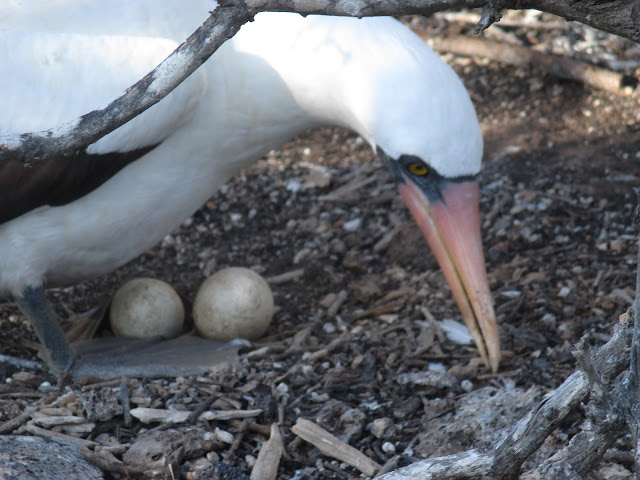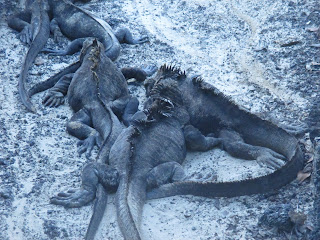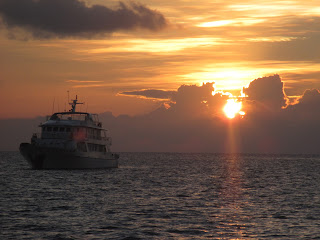Simply put: The Galapagos Islands are extraterristrial. There is no other place like it on earth.
The Galapagos didn't use to be as desirable of a location as it is now. In fact it wasn't even claimed as Ecuadorian territory until 1832. (Darwin came and did his research on his around the world tour in 1835.) He only spent 5 weeks in the Galapagos and much more time in Brazil and other countries.
When I first arrived this was what greeted me by the harbor.
Through enough chatter on the backpacker circuit realized I needed more time than I had originally planned for the Galapagos. I changed my approach & flights completely. When I arrived, I hopped around to different travel agencies looking for a last minute "cheap" cruise. Basically, there are 4 inhabited islands on the Galapagos. (Even the closest Islands are about 2.5 hours apart.) So it makes Island hopping not as easy as it could appear. When I arrived, I was able to book a 3 night 4 day cruise. The major advantage of the cruise is that you get to visit the faraway islands that cannot normally be reached.
Sea turtle nesting marker
During WW2 the American Government built an airport in the Galapagos so they could protect Panama. On our first day we went to a beach called "Bachas." The only reason why it was called this is usually the American barges were anchored there and the Ecuadorians could not say that word so it turned into Bachas Beach.
This crab has a nickname of "Red Headed Sally" because every 2 weeks the Americans would fly in girls to entertain the troops. Apparently there was a famous red head named Sally that was very popular & seemed to be everywhere.
After our first night, we woke up on a far northern island called Genovesa. I have never seen so many birds in my life. This is the male frigate bird which is like a big, lazy bully. He basically steals most of his food & supplies from all the other surrounding birds. He bulges his chest as a mating call.

The only reason why they were riding along with us is we were crossing over 1 of the 2 safe locations to dump organic waste and they wanted food.

Caution: We had a lot of luck (no pun entended) as it was mating & nesting season in the Galapagos. We saw penguins, birds, and sea turtles mating.
I love this picture because you can see multiple spatter cones that came from exploding lava from the nearby volcano.
 Above is Bartholomew Island. It was our guide's favorite Island. I also found it colorful and fascinating. Along with the animals taking on different characteristics in every island the terrain and plants do the same. This Island was formed by a nearby volcano. These 2 Islands were 10 minutes apart by motor boat, and were formed around 1910 from the same volcano and they had a completely different terrain.
Above is Bartholomew Island. It was our guide's favorite Island. I also found it colorful and fascinating. Along with the animals taking on different characteristics in every island the terrain and plants do the same. This Island was formed by a nearby volcano. These 2 Islands were 10 minutes apart by motor boat, and were formed around 1910 from the same volcano and they had a completely different terrain.
This is a prickly pear cactus. It is very common on many of the islands. If iguanas live on the islands it goes through the process of producing long spines like you see in this pictures. Then it will eventually grow up really long and have a smooth surface like in the picture above so the iguanas cannot climb up the tree to get the fruit. All very different from this cactus & the traditional prickly pear cactus that we have in Texas (this island wasn't inhabited by iguanas.)

Galapagos hosts 3 types of Boobies: Red Footed Booby, Nasca Booby, & the Blue Footed Booby.

One rather unfortunate thing about the Nasca boobies is they lay 2 eggs 10 days apart. The older sibling usually kills the younger one because there is not enough food for both of them.
I like to call this photo: "like father like son."
Land Iguanas
Marine Iguanas

After my cruise, I took a ferry over the Isla Isabela. I rented a bike and went on this really fun trail to the "Muro de Lagrimas." or "The Wall of Tears." It was a great ride with all these interesting views of wetlands, animals, and beaches.

The Galapagos people are very series about protecting their animals and islands. To the point where you cannot bring fresh produce from island to island. They actively kill non native animals that are out of "safe zones" because they are such a threat the the native species.
I like to correlate the Galapagos Islands to Australia. Both having a similar background of shipping off convicts to remote areas instead of dealing with them on the mainland. There is not very much known about this time period in Ecuador and the only remaining artifacts they have is this "Wall of tears" that was constructed.
Los Túneles
This was a really exciting day trip. I got to snorkel in all these interesting tunnels and caves. We saw tons of blue footed boobies, sea lions, sea horses that were like 8 inches long, white tip sharks, sea turtles, a sting ray, and tons of fish.









































